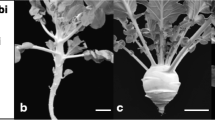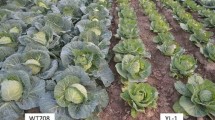Abstract
Cabbage head splitting can greatly affect both the quality and commercial value of cabbage (Brassica oleracea). To detect the genetic basis of head-splitting resistance, a genetic map was constructed using an F2 population derived by crossing “748” (head-splitting-resistant inbred line) and “747” (head-splitting-susceptible inbred line). The map spans 830.9 cM and comprises 270 markers distributed in nine linkage groups, which correspond to the nine chromosomes of B. oleracea. The average distance between adjacent markers was 3.6 cM. A total of six quantitative trait loci (QTLs) conferring resistance to head splitting were detected in chromosome 2, 4, and 6. Two QTLs, SPL-2-1 and SPL-4-1, on chromosomes 2 and 4, respectively, were detected in the experiments over 2 years, suggesting that these two potential loci were important for governing the head-splitting resistance trait. Markers BRPGM0676 and BRMS137, which were tightly linked with head-splitting resistance, were detected in the conserved QTL SPL-2-1 region using bulked segregant analysis. Synteny analysis showed that SPL-2-1 was anchored to a 3.18-Mb genomic region of the B. oleracea genome, homologous to crucifer ancestral karyotype E block in chromosome 1 of Arabidopsis thaliana. Moreover, using a field emission scanning electron microscope, significant differences were observed between the two parental lines in terms of cell structures. Line “747” had thinner cell wall, lower cell density, larger cell size, and anomalous cell wall structure compared with the resistant line “748.” The different cell structures can provide a cytological base for assessing cabbage head splitting.




Similar content being viewed by others
References
Andersen PC, Richardson DG (1982) A rapid method to estimate fruit water status with special reference to rain cracking of sweet cherries. J Am Soc Hortic Sci 107:441–444
Bohuon E, Keith D, Parkin I, Sharpe A, Lydiate D (1996) Alignment of the conserved C genomes of Brassica oleracea and Brassica napus. Theor Appl Genet 93(5):833–839
Chiang MS (1972) Inheritance of head splitting in cabbage (Brassica oleracea L. var. Capitata L.). Euphytica 21:507–509
Christensen JV (1976) Cracking in cherries. Dan J Plant Soil Sci 80:289–324
Demirsoy L, Demirsoy H (2004) The epidermal characteristics of fruit skin of some sweet cherry cultivars in relation to fruit cracking. Pak J Bot 36(4):725–731
Emmons CLW, Scott JW (1997) Environmental and physiological effects on cuticle cracking in Tomato. J Am Soc Hortic Sci 122:797–801
Farinho M, Coelho P, Carlier J, Svetleva D, Monteiro A, Leitao J (2004) Mapping of a locus for adult plant resistance to downy mildew in broccoli (Brassica oleracea var. Italica). Theor Appl Genet 109(7):1392–1398
Huang XM, Wang HC, Li JG et al (2004) Pericarp structure in relation to fruit cracking resistance in litchi (Litchi chinensis Sonn.). Acta Hortic 632:131–137
Iniguez-Luy FL, Voort AV, Osborn TC (2008) Development of a set of public SSR markers derived from geomic sequence of a rapid cycling Brassica oleracea L. genotype. Theor Appl Genet 117:977–985
Iniguez-luy FL, Lukens L, Farnham MW, Amasion RM, Osborn TC (2009) Development of public immortal mapping populations, molecular markers and linkage maps for rapid cycling Brassica rapa and B. oleracea. Theor Appl Genet 120:31–43
Kasai S, Hayama H, Kashimura Y, Kudo S, Osanai Y (2008) Relationship between fruit cracking and expression of the expansin gene MdEXPA3 in ‘Fuji’ apples (Malusdomestica Borkh.). Sci Hortic 116:194–198
Kosambi DD (1944) The estimation of map distances from recombination values. Ann Eugen 12:172–175
Li X, Ramchiary N, Choi SR, Nguyen VD, Hossain MJ, Yang HK, Lim YP (2010) Development of high density integrated reference genetic linkage map for multinational Brassica rapa genome sequencing project. Genome 53:939–947
Li X, Ramchiary N, Dhandapani V, Choi SR, Yang HK, Nou IS, Yoon MK, Lim YP (2013) Quantitative trait loci mapping in Brassica rapa revealed the structural and functional conservation of genetic loci governing morphological and yield component traits in the A, B, and C subgenomes of Brassica species. DNA Res 20:1–16
Liu S, Liu Y, Tong C et al (2014) The Brassica oleracea genome reveals the asymmetrical evolution of polyploid genomes. Nat Commun 5:3930. doi:10.1038/ncomms4930
Lowe AJ, Jones AE, Raybould AF, Trick M, Moule CJ, Edwards KJ (2002) Transferability and genome specificity of a new set of microsatellite primers among Brassica species of the U triangle. Mol Ecol Notes 2:7–11
Lowe AJ, Moule C, Trick M, Edwards KJ (2004) Efficient large-scale development of microsatellites for marker and mapping applications in Brassica crop species. Theor Appl Genet 108:1103–1112
Matas AJ, Cobb ED, Paolillo DJ, Niklas KJ (2004) Crack resistance in cherry tomato fruit correlates with cuticular membrane thickness. HortScience 39:1354–1358
Moctezuma E, Smith DL, Gross KC (2003) Antisense suppression of a beta-galactosidase gene (TBG6) in tomato increased fruit cracking. J Exp Bot 54:2025–2033
Niu N, Zheng C, Zhang L, Xu Y, Zhang L, Fu W (2010) Inheritance and RAPD marker of head-splitting trait in Chinese cabbage. China Veg 14:44–48
Panjabi P, Jagannath A, Bisht NC, Padmaja KL, Sharma S, Gupta V, Pradhan AK, Pental D (2008) Comparative mapping of Brassica juncea and Arabidopsis thaliana using intron polymorphism (IP) markers: homoeologous relationships, diversification and evolution of the A, B and C Brassica genomes. BMC Genom 9:113
Peet MM (1992) Fruit cracking in tomato. HortTechnol 2:216–223
Peet MM, Willits DH (1995) Role of excess water in tomato fruit cracking. HortScience 30:65–68
Piao ZY, Deng YQ, Choi SR, Park YJ, Lim YP (2004) SCAR and CAPS mapping of CRb, a gene conferring resistance to Plasmodiophora brassicae in Chinese cabbage (Brassica rapa ssp. pekinensis). Theor Appl Genet 108:1458–1465
Piquemal J, Cinquin E, Couton F, Rondeau C, Seignoret E, Perret D, Villeger MJ, Vincourt P, Blanchard P (2005) Construction of an oilseed rape (Brassica napus L.) genetic map with SSR markers. Theor Appl Genet 111:1514–1523
Proctor JTA, Lougheed EC (1980) Cracking of Golden Russet apples. Can Plant Dis Surv 60:55–58
Radoev M, Becker HC, Ecke W (2008) Genetic analysis of heterosis for yield and yield components in rapeseed (Brassica napus L.) by quantitative trait locus mapping. Genetics 179:1547–1558
Reynard GB (1960) Breeding tomatoes for resistance to fruit cracking. Proc Plant Sci FESEMinar. Campbell Soup Co, Camden, pp 19–36
Savvas D, Ntatsi G, Passam HC (2008) Plant nutrition and physiological disorders in greenhouse grown tomato, pepper and eggplant. Eur J Plant Sci Biotechnol 2:45–61
Schranz ME, Lysak MA, Mitchell-Olds T (2006) The ABC’s of comparative genomics in the Brassicaceae: building blocks of crucifer genomes. Trends Plant Sci 11:535–542
Slocum M, Figdore S, Kennard W, Suzuki J, Osborn T (1990) Linkage arrangement of restriction fragment length polymorphism loci in Brassica oleracea. Theor Appl Genet 80(1):57–64
Smooker AM, Wells R, Morgan C, Beaudoin K, Fraser CF, Bancroft I (2011) The identification and mapping of candidate genes and QTL involved in the fatty acid desaturation pathway in Brassica napus. Theor Appl Genet 122:1075–1090
Stam P (1993) Construction of integrated genetic linkage maps by means of a new computer package: JoinMap. Plant J 3:739–744
Su YB, Liu YM, Fang ZY, Yang LM, Zhuang M, Zhang YY, Zhang XL, Sun PT (2012) Genetic analysis of head-splitting resistance traits in cabbage. Acta Hortic Sin 39(8):1482–1490
Suwabe K, Iketani H, Nunome T, Kage T, Hirai M (2002) Isolation and characterization of microsatellites in Brassica rapa L. Theor Appl Genet 104:1092–1098
Suwabe K, Tsukazaki H, Iketani H, Hatakeyama K, Kondo M, Fujimura M, Nunome T, Fukuoka H, Hirai M, Matsumoto S (2006) Simple sequence repeat-based comparative genomics between Brassica rapa and Arabidopsis thaliana: the genetic origin of clubroot resistance. Genetics 173:309–319
Tang H, Woodhouse MR, Cheng F, Schnable JC, Pedersen BS, Conant G, Wang X, Freeling M, Pires JC (2012) Altered patterns of fractionation and exon deletions in Brassica rapa support a two-step model of paleohexaploidy. Genetics 190:1563–1574
Uzunova MI, Ecke W (1999) Abundance, polymorphism and genetic mapping of microsatellites in oilseed rape (Brassica napus L.). Plant Breed 118:323–326
Van Ooijen JW (2006) Joinmap 4, software for the calculation of genetic linkage maps in experimental populations. Kyazma BV, Wageningen
Walter JC (1967) Hereditary resistance to disease in tomato. Annu Rev Phytopathology 5:131–162
Wang Y, Lu W, Li J, Jiang Y (2006) Differential expression of two expansin genes in developing fruit of cracking-susceptible and -resistant litchi cultivars. J Am Soc Hortic Sci 131:118–121
Wang X, Wang H, Wang J et al (2011) The genome of the mesopolyploid crop species Brassica rapa. Nat Genet 43:1035–1039
Wang S, Basten CJ, Zeng Z-B (2012a) Windows QTL Cartographer 2.5. Department of Statistics, North Carolina State University, Raleigh, NC. http://statgen.ncsu.edu/qtlcart/WQTLCart.htm
Wang W, Huang S, Liu Y et al (2012b) Construction and analysis of a high density genetic linkage map in cabbage (Brassica oleracea L. var.capitata). BMC Genom 13:523
Young HW (1959) Inheritance of radial fruit cracking in a tomato cross. Proc Fla State Hort Soc 72:207–210
Zeng A, Liu Y, Fang Z, Yan J (2011) Research progress of head splitting on cabbage (Brassica oleracea L. var. capitata L.). J Plant Genet Resour 2:307–310
Zhuang M, Zhang Y, Fang Z, Liu Y, Yang L, Sun P (2009) Studies on combining ability and heritability of splitting resistance characteristic in cabbage (Brassica oleracea var. capitata L.). China Veg 1:12–15
Acknowledgments
This work was supported by the Golden Seed Projet (No. 213002-04-1-SB110), Ministry of Agriculture, Food and Rural Affairs (MAFRA), Ministry of Oceans and Fisheries (MOF), Rural Development Administration (RDA), and Korea Forest Service (KFS).
Author information
Authors and Affiliations
Corresponding author
Additional information
Wenxing Pang and Xiaonan Li have contributed equally to this work.
Electronic supplementary material
Below is the link to the electronic supplementary material.
Fig. S1
Continuous distribution of head-splitting severity displayed in the F2:3 segregating population in year 2012 (A) and 2014 (B) experiment, respectively. (PPTX 72 kb)
Rights and permissions
About this article
Cite this article
Pang, W., Li, X., Choi, S.R. et al. Mapping QTLs of resistance to head splitting in cabbage (Brassica oleracea L.var. capitata L.). Mol Breeding 35, 126 (2015). https://doi.org/10.1007/s11032-015-0318-1
Received:
Accepted:
Published:
DOI: https://doi.org/10.1007/s11032-015-0318-1




